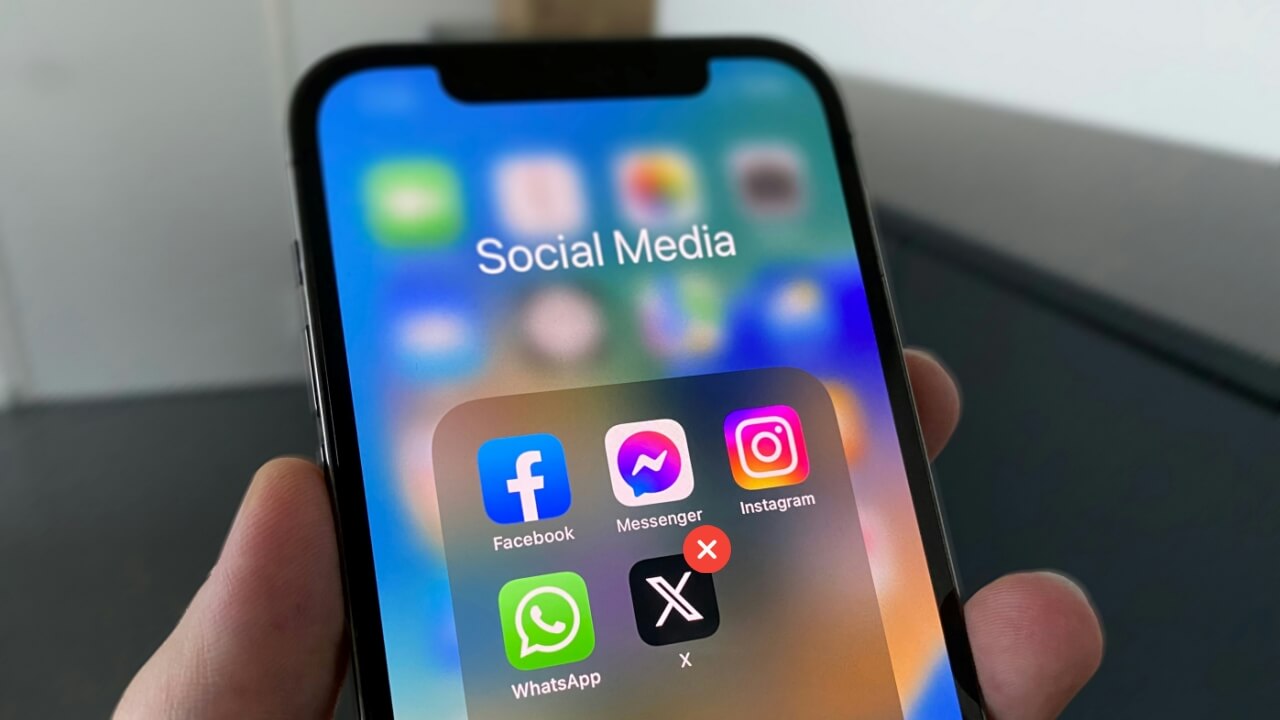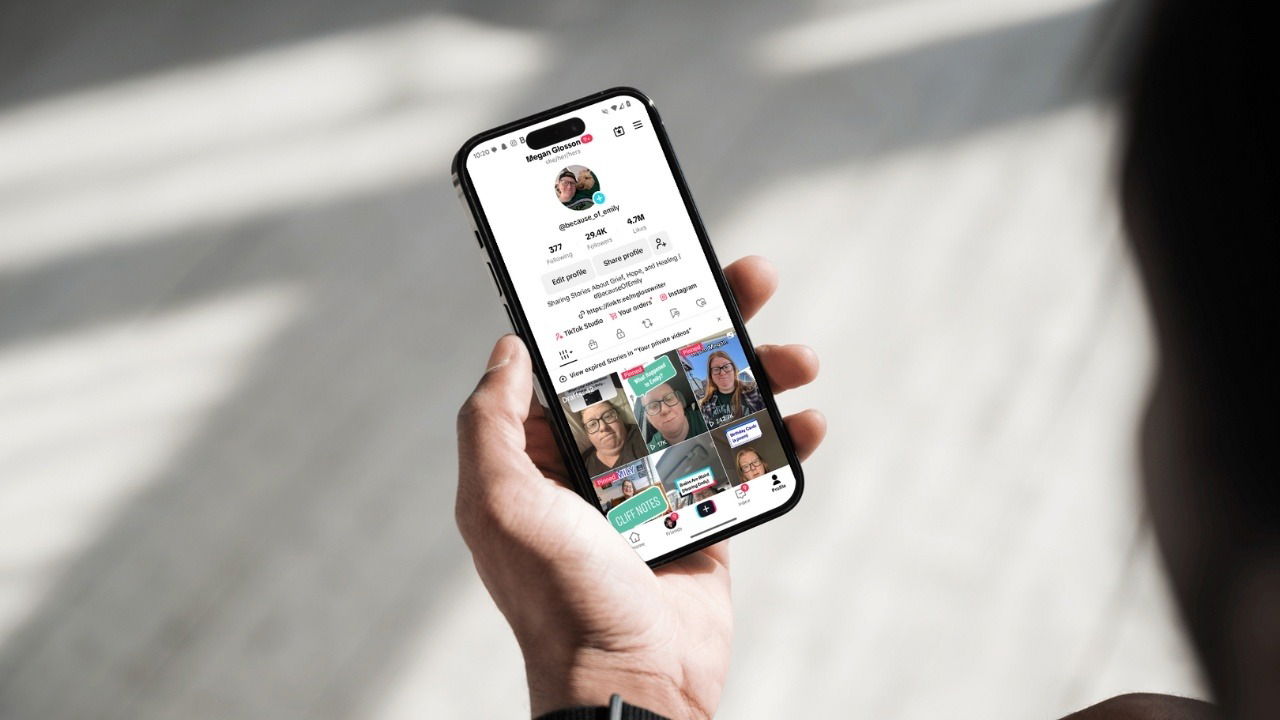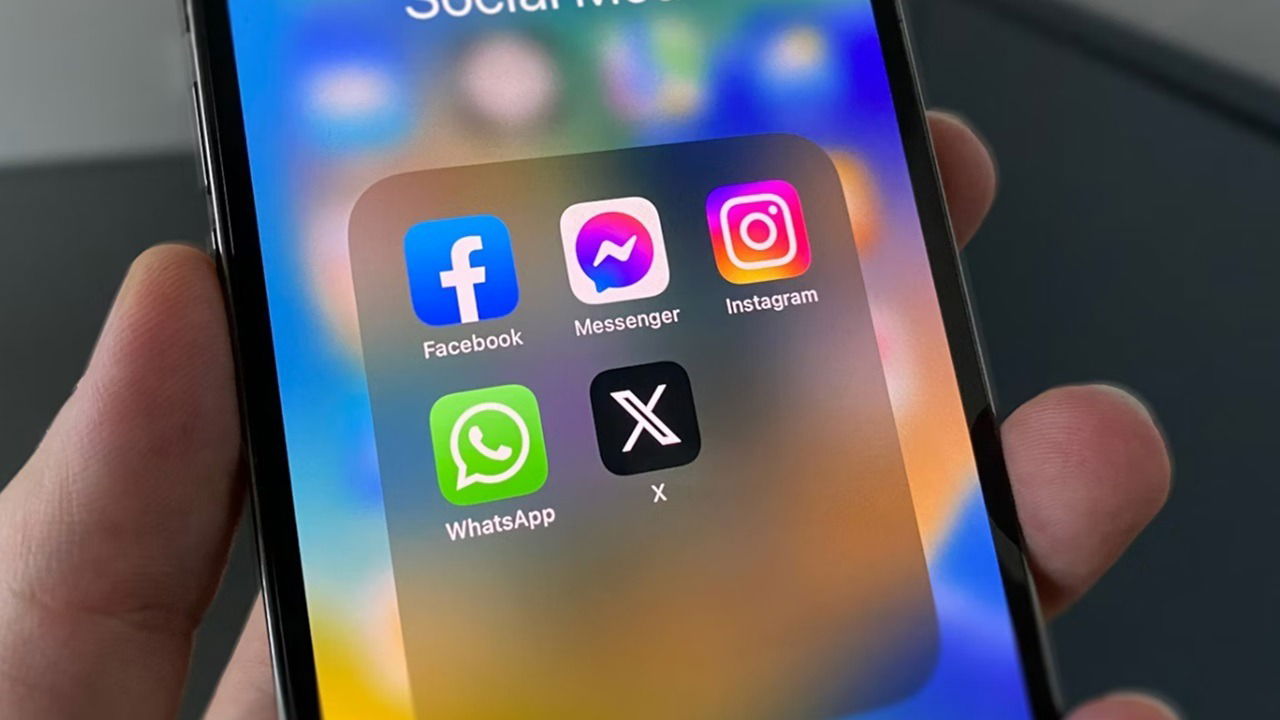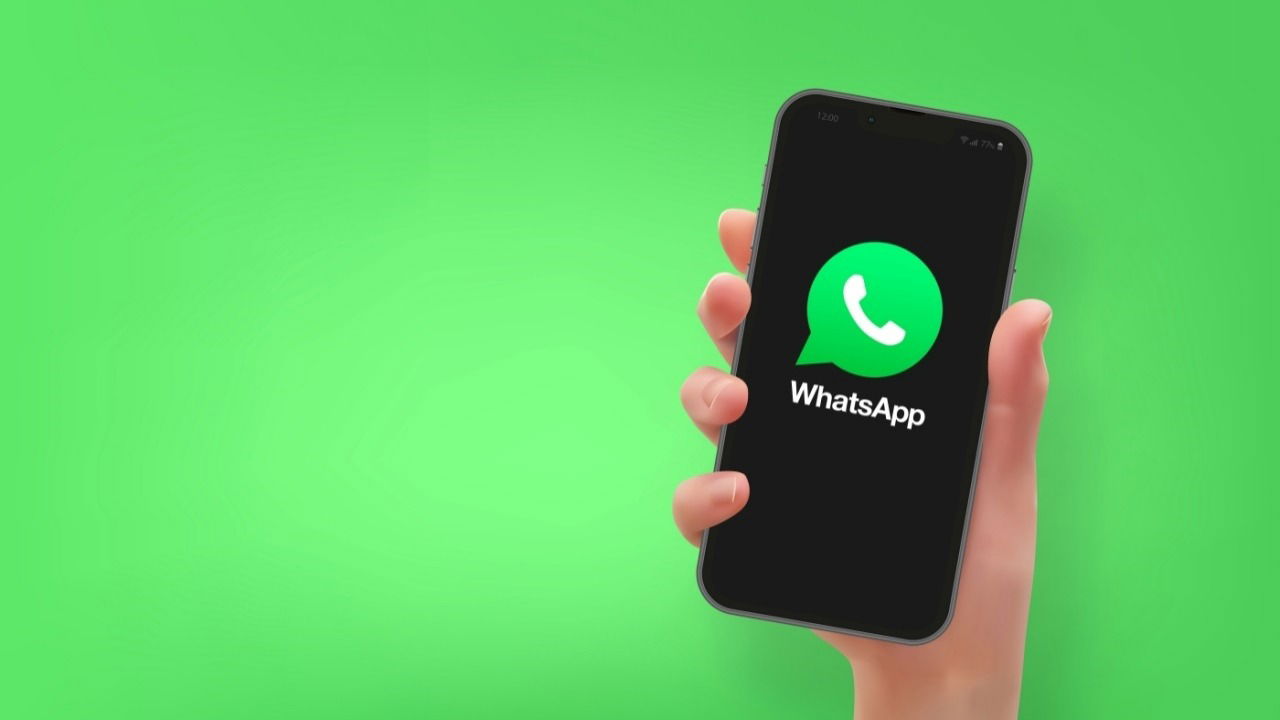
WhatsApp is widely used where I live, making it hard to avoid entirely. Fortunately, if you’d like to limit interactions and keep a low-key presence, WhatsApp provides privacy options that can help keep interactions on your terms, as I’ll show in this article.
- 1. Disabling Last Seen & Online Statuses
- 2. Preventing People From Viewing Profile Photo
- 3. Choosing Who Can View About Message
- 4. Restricting Visibility of Status Updates
- 5. Disabling Read Receipts
- 6. Enabling Disappearing Messages
- 7. Restricting Who Can Add Me to Groups
- 8. Silencing Unknown Callers
- 9. Setting an App Lock
- 10. Setting a Chat Lock
- 11. Enabling 2FA
- 12. Blocking Any Bothersome Contacts
- 13. Protecting IP Address
1. Disabling Last Seen & Online Statuses
With most people always connected to social media, it can feel like someone is always watching your online moves. I don’t particularly appreciate feeling under surveillance, so I opted to enable the Last Seen & Online stamps in WhatsApp. These show you when a person has visited WhatsApp last or whether they are currently online on the app.
Note that if you turn off these features, you will also lose the ability to see your friends’ last seen and online timestamps. For me, this is actually a relief – it helps ease my anxiety. Instead of constantly checking WhatsApp to see if the person I’m waiting on has been online, I can shift my attention to other things.
Note: Most privacy options such as these can only be modified from the WhatsApp mobile app.
On Android, press on the three dots in the upper right corner and select Settings. On iPhone tap on the Settings tab at the bottom.
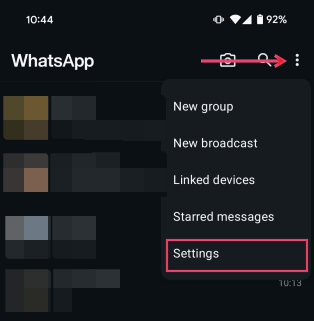
Go to Privacy.
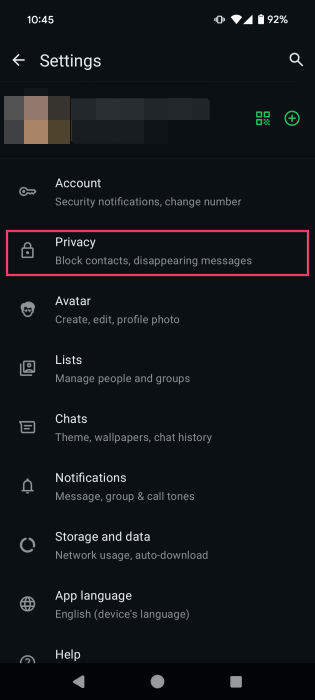
Select the first option called Last seen and online.
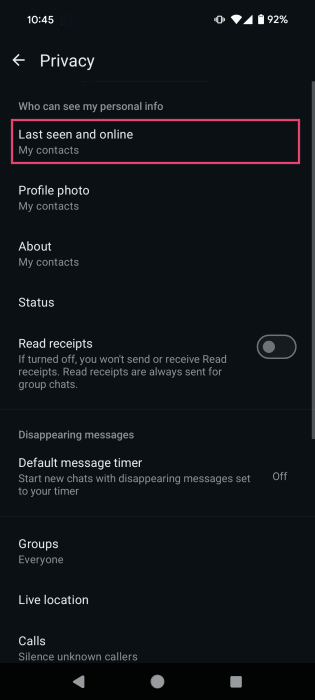
Switch to Nobody under Who can see my last seen. At the same time, tap on the same as last seen under Who can see when I’m online.
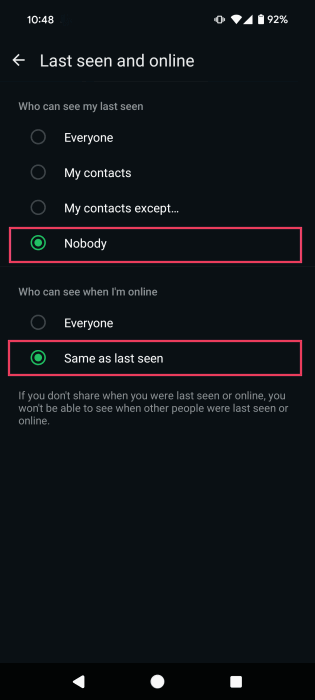
2. Preventing People From Viewing Profile Photo
On WhatsApp, anyone who saves my number can see my profile picture, which I find unsettling, as it may attract unwelcome attention. To address this, I customize my privacy settings to ensure only select people can view it.
Go to Settings -> Privacy -> Profile photo.
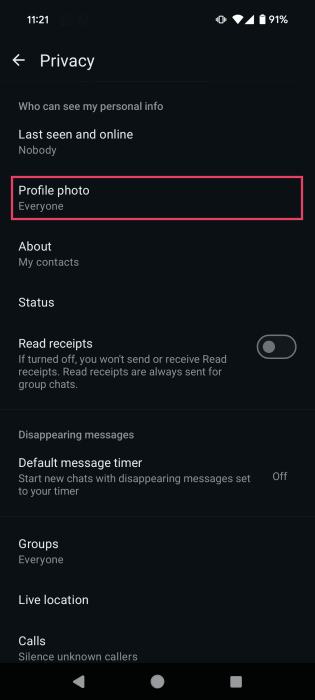
Select one of the options available, such as My contacts. If you want to have only a select group of contacts view your profile pic, opt for My contacts except… For complete profile pic anonymity, you can opt for Nobody.
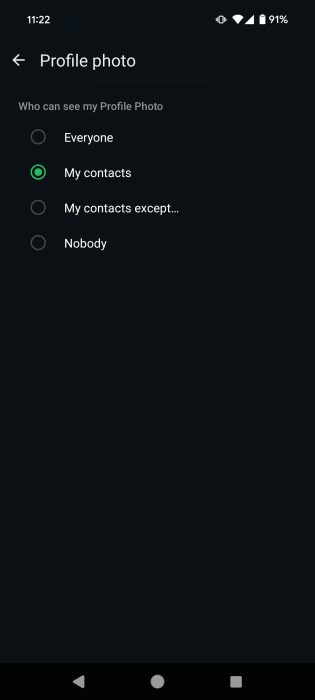
3. Choosing Who Can View About Message
The WhatsApp About message is like a mini personal statement. A good number of people may have sensitive or personal notes written in the statement, including myself, meaning they don’t want everyone to be able to view it. If you fall into this category, then follow the steps below.
Go to Settings -> Privacy -> About.
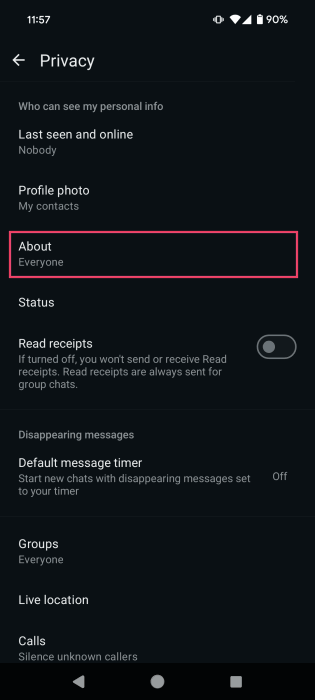
Change the visibility from the default Everyone to something else.
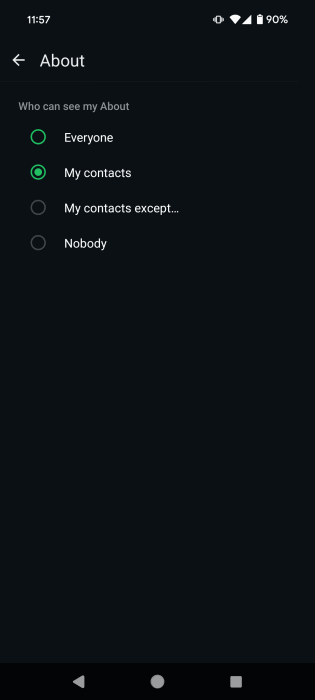
Tip: check how to create and share a WhatsApp profile link.
4. Restricting Visibility of Status Updates
The WhatsApp Status feature allows you to share pictures, notes, or short videos on your account. It’s similar to Instagram stories, and like on Instagram I prefer to keep these moments private and only share them with a handful of people.
Navigate to Settings -> Privacy -> Status.
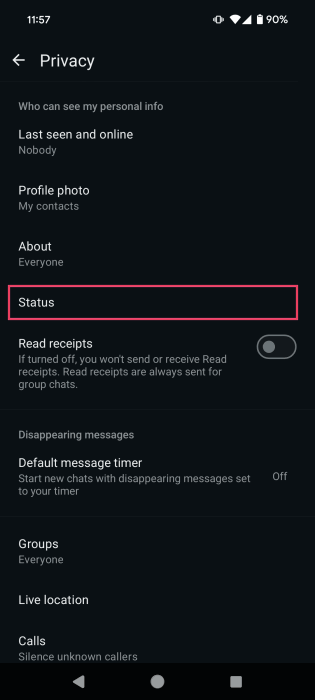
Here you can opt to share your status with your full list of contacts or create a custom list by either using the My contacts except or Only share with options.
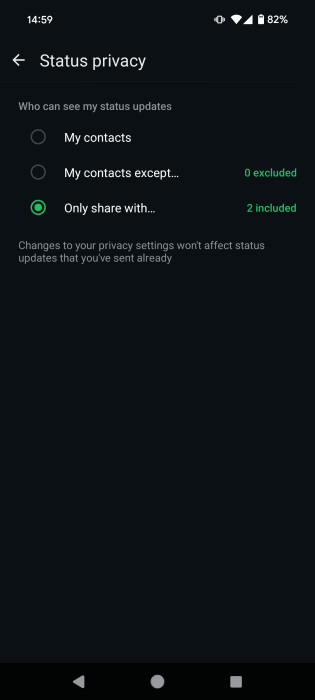
5. Disabling Read Receipts
In the era of instant messaging, there’s a growing expectation for immediate responses. Personally, though, I don’t enjoy the pressure to reply right away. Which is why I have disabled read receipts for messages. This means that I can read messages without the tick boxes underneath each message turning blue.
Like in the case of last seen, turning this option off will also prevent you from seeing when others have read your messages.
To disable read receipts, head to Settings -> Privacy.
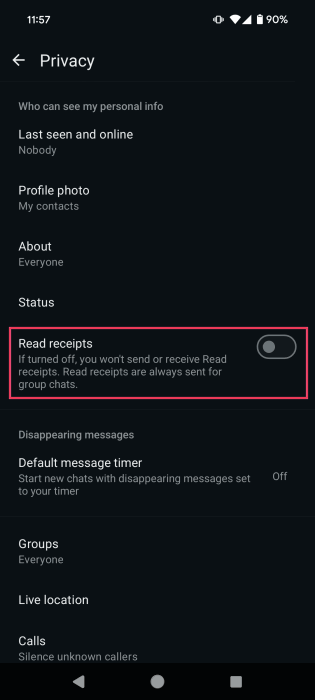
Turn the switch next to Read receipts off.
6. Enabling Disappearing Messages
Sometimes I like to limit how long a sensitive message remains accessible via the app. For instance, if I am planning to make a surprise gift to a loved one and I am discussing with other family members the specifics via chat.
To minimize the chances of any details leaking out and the surprise getting ruined, I may opt to enable disappearing messages for certain conversations. This ensures that messages automatically delete themselves from the chat after a chosen period (ranging from 24 hours to 90 days.)
To start sending disappearing messages to someone, open their chat window in WhatsApp. Then press on the three-dot menu in the upper right corner and select Disappearing messages.
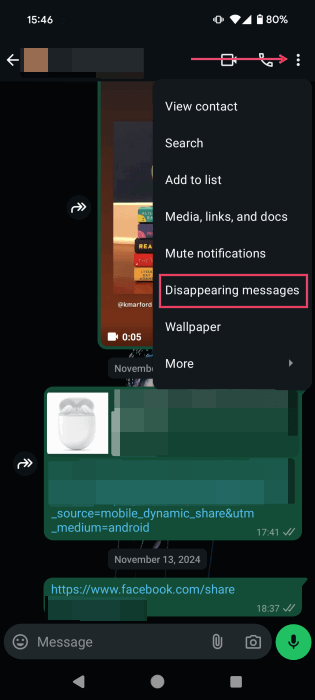
Select a message timer. That’s it, now the messages you sent to this particular person will self-destruct once the time has elapsed.
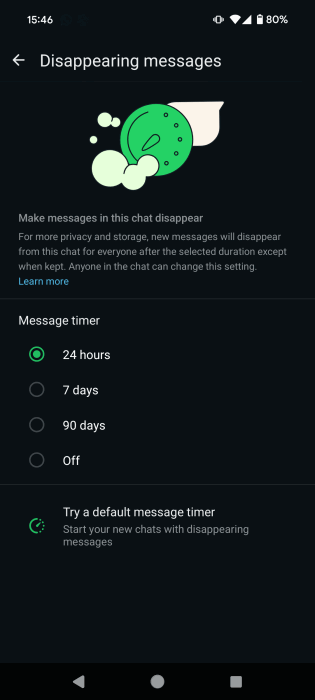
When it’s time to disable this feature, follow the same steps and opt for the Off option.
7. Restricting Who Can Add Me to Groups
I really dislike being randomly added to groups on WhatsApp. That happens because, by default, anyone can add you to their group, without asking. Fortunately, you can modify your privacy settings and restrict who can add you to groups.
Go to Settings -> Privacy -> Groups.
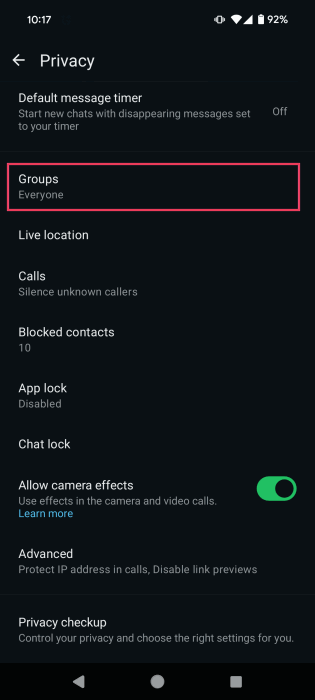
You can opt to have only your contacts add you to groups. Or you can create a custom list of contacts who can do so. Note that admins who can’t add you to a group can invite you privately instead.
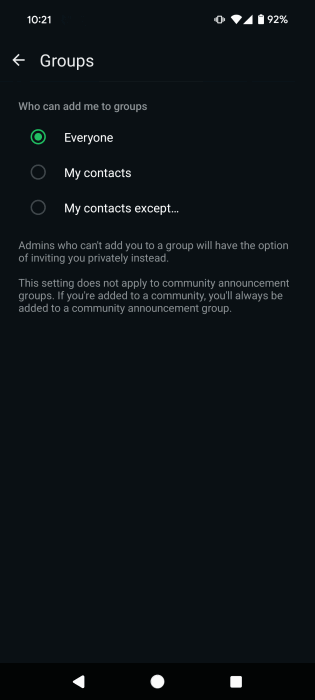
8. Silencing Unknown Callers
Don’t want to be bothered by strange calls while using WhatsApp? I have enabled protection against this nuisance by silencing unknown callers.
Go to Settings -> Privacy -> Calls.
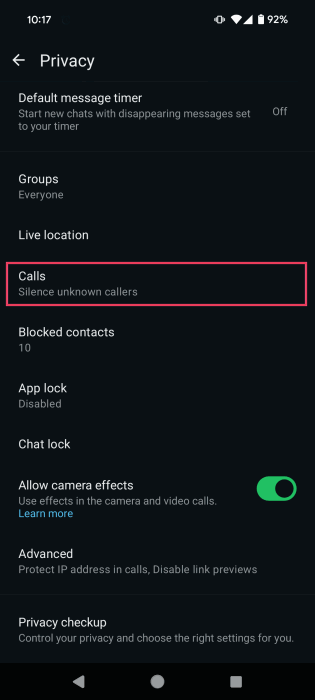
Toggle on the Silence unknown callers options at the top.
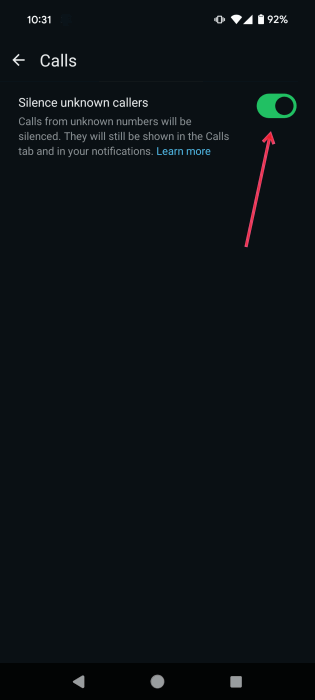
A similar option can be found under Settings -> Privacy -> Advanced. From here, enable Block unknown account messages to minimize random people contacting you.
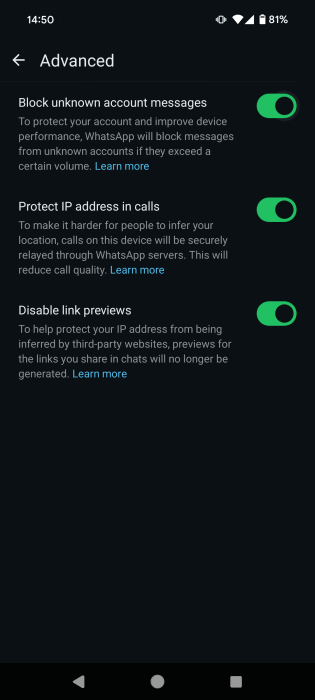
FYI: did you know you can message yourself on WhatsApp? Here’s how.
9. Setting an App Lock
To keep my WhatsApp chats more secure, I have enabled a lock on the app. This way, if someone gets hold of my phone, they’ll need to enter an additional password (or use biometric authentication) to view my conversations.
Navigate to Settings -> Privacy -> App lock.
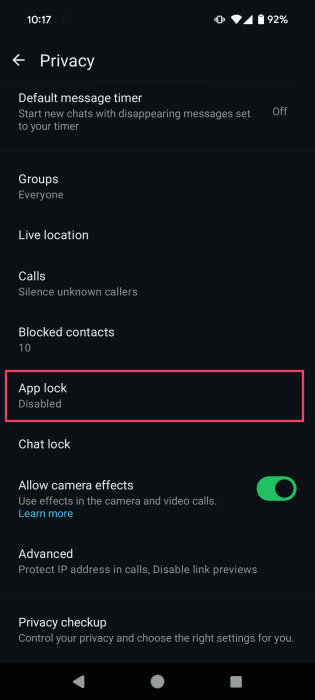
Because my phone supports biometric authentication, the option I see is Unlock with biometric. This means you can unlock the app using a fingerprint or other unique identifiers.
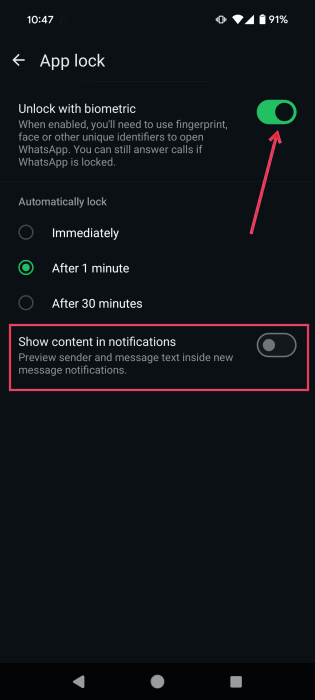
Once enabled, make sure you turn the Show content in notifications toggle off too.
10. Setting a Chat Lock
At times, I open WhatsApp without knowing who’s behind me, potentially exposing sensitive information on my screen. To avoid that, when I’m traveling, for instance, I enable chat lock for some of my most intimate conversations.
To enable chat lock for a conversation, open WhatsApp and press on the person’s profile picture at the top.
Turn on the Chat lock toggle.
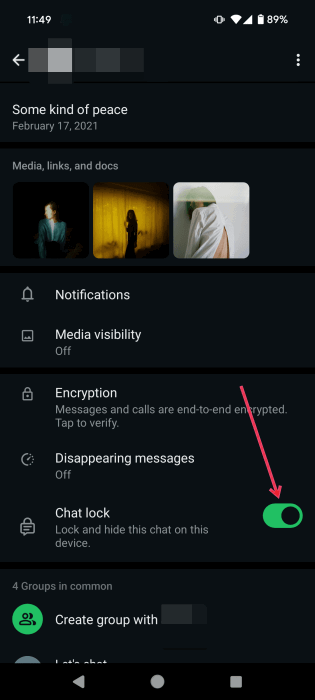
Press Continue on the pop-up message that appears at the bottom.
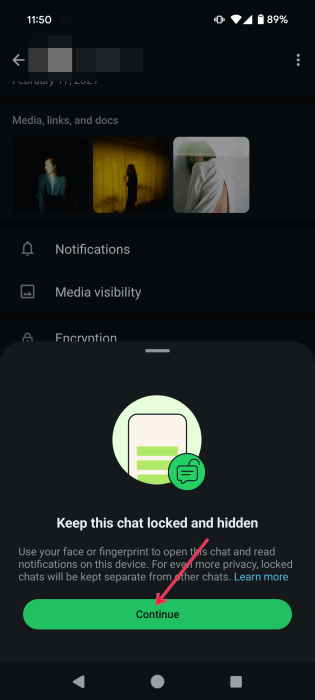
WhatsApp notifies you that in order to open a secret chat, you will need to use your fingerprint (or other biometrics.) Or you can opt for PIN.
Once you select and verify your option, WhatsApp will lock your chat. In addition, it will remove the chat thread from the inbox and hide the notification content too.
To find these chats, swipe from the top of WhatsApp. This will reveal a Locked chats folder at the top.
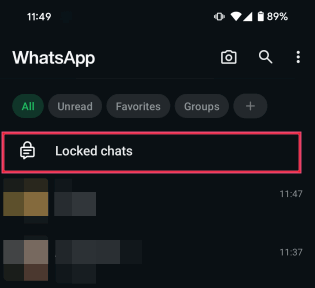
Tap on it and authenticate yourself. You can now access your locked chats. To disable Chat lock, follow the steps above and toggle off the option.
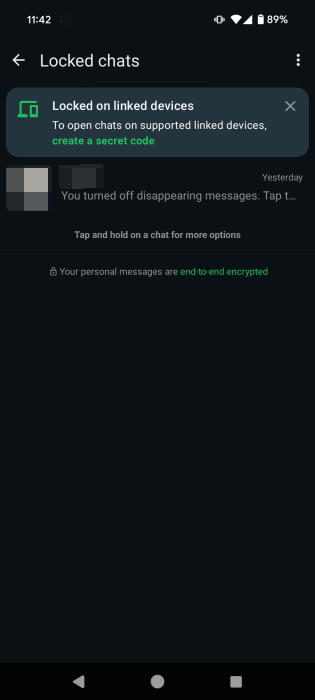
11. Enabling 2FA
I also suggest that you enable two-factor authentication for WhatsApp. This way you’re making it harder for unauthorized users to access your account even if they somehow get hold of your login credentials.
Refer to our article to learn how to turn on 2FA on WhatsApp and other social media apps.
12. Blocking Any Bothersome Contacts
When someone tests my patience past a certain point on WhatsApp, I will choose to protect my peace by blocking them and thus avoiding any further negativity.
On mobile
Open the chat with the contact you wish to block.
Tap on their name to show their details. Scroll to the bottom of the page and press Block.
Tap Block again in the pop-up to confirm.
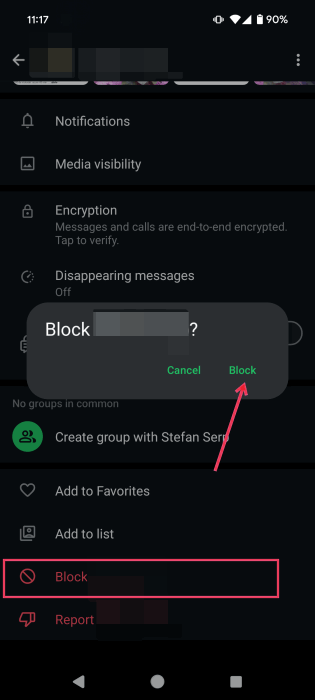
To unblock a contact, go to Settings -> Privacy -> Blocked contacts.
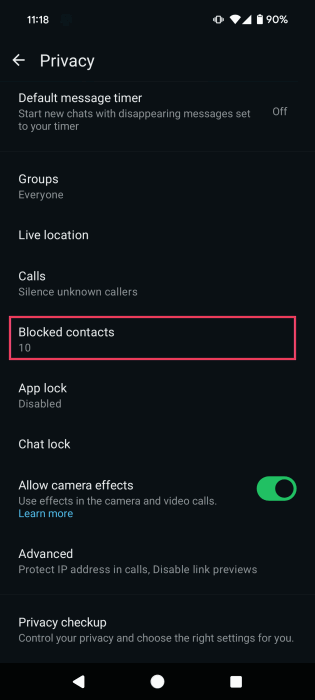
Select the contact you wish to unblock and complete the unblocking process.
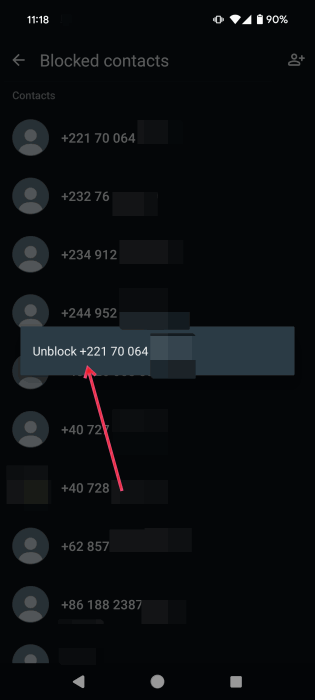
On PC
You can also block a contact from the WhatsApp desktop app.
Open a chat with the person in question and click on their profile picture at the top.
Press Block under Overview.
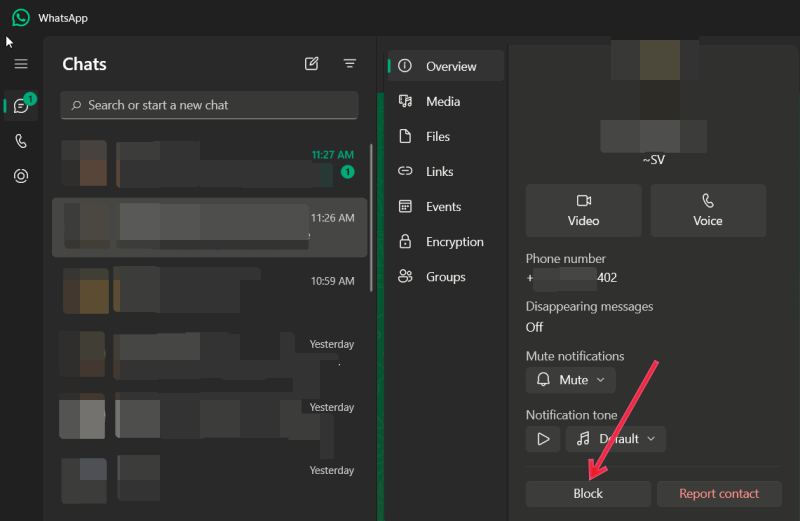
To manage your Blocked contacts list, you’ll need to revert to your phone.
13. Protecting IP Address
Your IP address can reveal your general location and other information about your internet connection. By protecting it, you can keep your location info and browsing habits private from unwanted tracking or surveillance. WhatsApp has a couple of options for addressing potential IP address breaches that I suggest you to enable.
Navigate to Settings -> Privacy -> Advanced in WhatsApp on your phone.
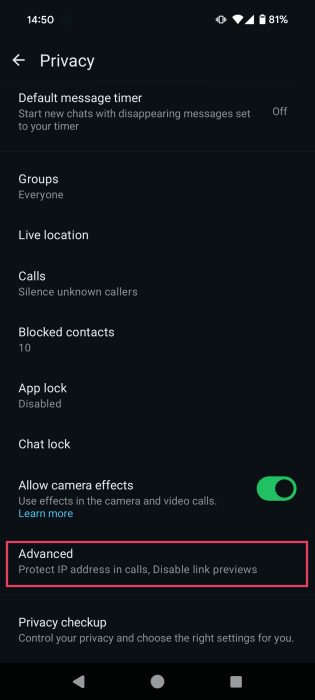
Turn on Protect IP address in calls and Disable link previews. The last one will protect your IP address from being inferred by third-party websites.

Now that you know how to make your WhatsApp experience a more private one, perhaps you’d also like to learn a few more tricks to make your WhatsApp experience better. You can check our post on how to create Lists on WhatsApp. Or perhaps you’d like to get up to speed on how to format text in WhatsApp chats.
Image credit: DepositPhotos All screenshots by Alexandra Arici
Our latest tutorials delivered straight to your inbox
